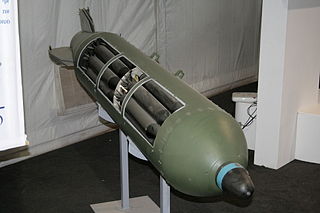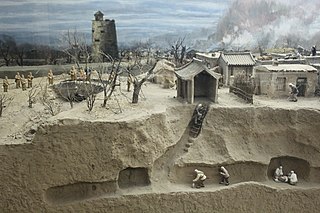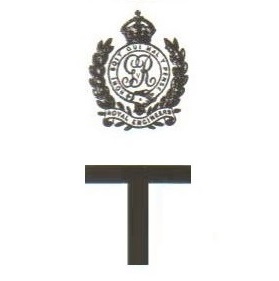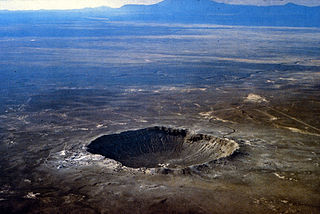Related Research Articles

A shaped charge is an explosive charge shaped to focus the effect of the explosive's energy. Different types of shaped charges are used for various purposes such as cutting and forming metal, initiating nuclear weapons, penetrating armor, or perforating wells in the oil and gas industry.

A bomb is an explosive weapon that uses the exothermic reaction of an explosive material to provide an extremely sudden and violent release of energy. Detonations inflict damage principally through ground- and atmosphere-transmitted mechanical stress, the impact and penetration of pressure-driven projectiles, pressure damage, and explosion-generated effects. Bombs have been utilized since the 11th century starting in East Asia.

A nuclear bunker buster, also known as an earth-penetrating weapon (EPW), is the nuclear equivalent of the conventional bunker buster. The non-nuclear component of the weapon is designed to penetrate soil, rock, or concrete to deliver a nuclear warhead to an underground target. These weapons would be used to destroy hardened, underground military bunkers or other below-ground facilities. An underground explosion releases a larger fraction of its energy into the ground, compared to a surface burst or air burst explosion at or above the surface, and so can destroy an underground target using a lower explosive yield. This in turn could lead to a reduced amount of radioactive fallout. However, it is unlikely that the explosion would be completely contained underground. As a result, significant amounts of rock and soil would be rendered radioactive and lofted as dust or vapor into the atmosphere, generating significant fallout.
A bunker buster is a type of munition that is designed to penetrate hardened targets or targets buried deep underground, such as military bunkers.
A tandem-charge or dual-charge weapon is an explosive device or projectile that has two or more stages of detonation, assisting it to penetrate either reactive armour on an armoured vehicle or strong structures.

Tallboy or Bomb, Medium Capacity, 12,000 lb was an earthquake bomb developed by the British aeronautical engineer Barnes Wallis and used by the Royal Air Force (RAF) during the Second World War.

Anti-runway penetration bombs are explosive weapons involving bombs or bomblets designed to damage or destroy runways, or otherwise render them unusable for aircraft.

A subsidence crater is a hole or depression left on the surface of an area which has had an underground explosion. Many such craters are commonly present at bomb testing areas; one notable example is the Nevada Test Site, which was historically used for nuclear weapons testing over a period of 41 years.

Originally known as the LAAAS, the JP233 is a British submunition delivery system consisting of large dispenser pods carrying several hundred submunitions designed to attack runways.

Tunnel warfare involves war being conducted in tunnels and other underground cavities. It often includes the construction of underground facilities in order to attack or defend, and the use of existing natural caves and artificial underground facilities for military purposes. Tunnels can be used to undermine fortifications and slip into enemy territory for a surprise attack, while it can strengthen a defense by creating the possibility of ambush, counterattack and the ability to transfer troops from one portion of the battleground to another unseen and protected. Also, tunnels can serve as shelter from enemy attack.
The earthquake bomb, or seismic bomb, was a concept that was invented by the British aeronautical engineer Barnes Wallis early in World War II and subsequently developed and used during the war against strategic targets in Europe. A seismic bomb differs somewhat in concept from traditional bombs, which usually explode at or near the surface, and destroy their target directly by explosive force. In contrast, a seismic bomb is dropped from high altitude to attain very high speed as it falls and upon impact, penetrates and explodes deep underground, causing massive caverns or craters known as camouflets, as well as intense shockwaves. In this way, the seismic bomb can affect targets that are too massive to be affected by a conventional bomb, as well as damage or destroy difficult targets such as bridges and viaducts.
The tsunami bomb was an attempt during World War II to develop a tectonic weapon that could create destructive tsunamis. The project commenced after US Navy officer E.A. Gibson noticed small waves generated by explosions used to clear coral reefs. The idea was developed by the United States and New Zealand military in a programme code named Project Seal. The weapons concept was deemed feasible, but the weapons themselves were never fully developed or used. A related concept, the bouncing bomb was developed and used in World War II, to be dropped into water as a means to destroy German dams and cause loss of industrial capacity and widespread flooding.

Sapping is a term used in siege operations to describe the digging of a covered trench to approach a besieged place without danger from the enemy's fire. The purpose of the sap is usually to advance a besieging army's position towards an attacked fortification. It is excavated by specialised military units, whose members are often called sappers.

The Disney bomb, also known as the Disney Swish, officially the 4500 lb Concrete Piercing/Rocket Assisted bomb was a rocket-assisted bunker buster bomb developed during the Second World War by the British Royal Navy to penetrate hardened concrete targets, such as submarine pens, which could resist conventional free-fall bombs.

Royal Engineer tunnelling companies were specialist units of the Corps of Royal Engineers within the British Army, formed to dig attacking tunnels under enemy lines during the First World War.

The Hohenzollern Redoubt action, 2–18 March 1916 was fought on the Western Front during the First World War. The Hohenzollern Redoubt was a German defensive position north of Loos-en-Gohelle (Loos), a mining town north-west of Lens in France. The Redoubt was fought over by the British and German armies from the Battle of Loos to the beginning of the Battle of the Somme on 1 July 1916. Over the winter of 1915–1916, the 170th Tunnelling Company RE dug several galleries under the German lines in the area of the redoubt, which had changed hands several times since September 1915. In March 1916, the west side was held by the British and the east side was occupied by the Germans, with the front near a new German trench known as The Chord. No man's land had become a crater field and the Germans had an unobstructed view of the British positions from the Fosse 8 slag heap. The British front line was held by outposts to reduce the number of troops vulnerable to mine explosions and the strain of knowing that the ground could erupt at any moment.

The Mines in the Battle of Messines comprised a series of underground explosive charges which were fired during the First World War at the start of the Battle of Messines (7–14 June 1917) by the British Second Army near the village of Mesen in Belgian West Flanders. The mines, secretly planted and maintained by British tunnelling units beneath the forward position of the German 4th Army, killed approximately 10,000 German soldiers and created 19 large craters. Their joint explosion ranks among the largest non-nuclear explosions of all time.

On the morning of 1 July 1916, the first day of the Battle of the Somme during World War I, underground explosive charges planted by British tunnelling units were detonated beneath the German front lines. The joint explosion of these mines ranks among the largest artificial non-nuclear explosions.

The Y Sap mine was an underground explosive charge, secretly planted by the British during the First World War and ready for 1 July 1916, the first day on the Somme. The mine was dug by the Tunnelling Companies of the Royal Engineers under a German machine-gun nest known as Blinddarm (appendix) in the front line, on the north side of the village of La Boisselle in the Somme département. The mine was named after Y Sap, the British trench from which the gallery was driven. It was one of 19 mines on the British sector to be blown at the start of the battle.

A crater is a landform consisting of a hole or depression on a planetary surface, usually caused either by an object hitting the surface, or by geological activity on the planet. A crater has classically been described as: "a bowl-shaped pit that is formed by a volcano, an explosion, or a meteorite impact". On Earth, craters are "generally the result of volcanic eruptions", while "meteorite impact craters are common on the Moon, but are rare on Earth".
References
- ↑ "US MIL: Camouflet". Archived from the original on 2011-06-04. Retrieved 2009-02-28.
- ↑ Dictionary of Fortifications: Camouflet
- ↑ "Harry Beckingham obituary". The Telegraph. Retrieved 2 April 2014.